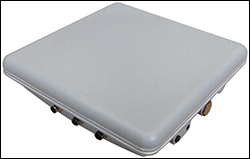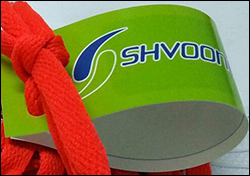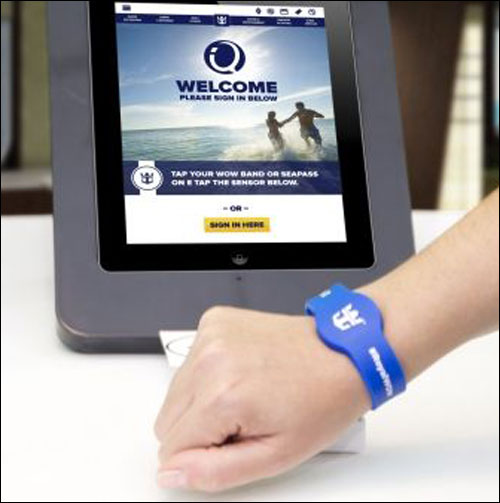The following are news announcements made during the past week by the following organizations:
IDTronic;
Estimote, Tapme Media;
Tadbik Advanced Technologies, RFID Race Timing Systems, RaceTec, Smartrac;
Guard RFID Solutions; Palex Medical; and
ASSA Abloy.
IDTronic Intros New Industrial UHF Readers With Integrated Antennas
IDTronic has announced a new ultrahigh-frequency (UHF) reader with an integrated auto-tuning antenna that is suitable for industrial and outdoor environments. The new Bluebox CX-AVI and CX-AVI LR readers are equipped with Ethernet and RS232/RS485 interfaces for a flexible and low-cost installation, according to iDTronic, and works well for parking, waste-management, forklift and logistics applications.
The devices support the ISO 18000-6C and EPC Gen 2 standards, are made of die-cast aluminum and plastic, and feature an IP 65 rating, meaning they are dust-tight and protected from splashed water. They deliver up to 27dBm in power output, which can be regulated through software commands. The CX-AVI measures 190 millimeters by 190 millimeters by 80 millimeters (7.5 inches by 7.5 inches by 3.1 inches) and supports a reading distance of up to 8 meters (26 feet), while the CX-AVI LR measures 308 millimeters by 308 millimeters by 85 millimeters (12 inches by 12 inches by 3 inches) and supports a reading distance of up to 10 meters (33 feet). Both versions are available for the ETSI or FCC frequency band and support iDTronic’s Bluebox software developer’s kit (SDK), which includes a demo tool for Microsoft Windows XP, Windows 7 or Windows 8. There is also programming information for C# and C++, as well as a serial command protocol.
Netherlands’ Groninger Museum Launches Beacon-enabled App
Groninger Museum, a modern and contemporary art museum in the Netherlands, has launched a new, beacon-enabled mobile app in conjunction with the opening of a new exhibition, “Song Dong, Life is Art, Art is Life.” The museum app is the first implementation of a new platform called Tapart, developed by Tapme Media, also in the Netherlands.
The mobile app presents information about artwork and sections of the museum as visitors walk around the Groningen facility and “tap” their smart devices to beacons that employ Bluetooth Smart technology. The Bluetooth beacons, supplied by Estimote, direct the mobile app to access and display specific Web content to visitors. The signal can be detected by a compatible smart device (iOS 7 and higher or Android 4.3 and higher).
The museum app is available for download at Google Play and iTunes.
Tadbik Shoe Tags Keep Time at the Nike Women’s 5K in Istanbul
Israeli labeling solutions company Tadbik Advanced Technologies has announced that its passive ultrahigh-frequency (UHF) RFID shoe tag and related RFID equipment, all compliant with the EPC Gen 2 standard, was used to keep time for the recent Nike Women’s Run Istanbul 5K, which featured approximately 2,500 women and is part of a Nike worldwide race series.
The event was timed by means of Tadbik’s RFID-enabled shoe tags and RFID Race Timing Systems‘ Ultramats, modular antenna mat systems that are designed for sporting events, according to Michal Yanuv Max, Tadbik’s sales and marketing director. The mats measure 1 meter (3.3 feet) in length by 0.55 meter (1.8 feet) in width by 20 millimeters (0.8 inch) in thickness, feature a special non-slip surface and are tough enough to handle trucks driving over them, the company reports. The entire RFID timing system at the Istanbul race was managed via RaceTec software. The durable Tadbik shoe tag featured a Smartrac DogBone Monza 4D paper inlay encoded with a runner’s number and printed with that number and application instructions. The shoe tag was branded with the Nike Women’s Race logo, Yanuv Max says, and runners tied the tags to their shoelaces.
In addition, three RFID-powered kiosks were used at the event venue to display individual results. The kiosks featured proprietary software designed to access the RaceTec database, as well as FX7500 readers made by Zebra Technologies (formerly Motorola Solutions’ RFID division).
The RFID system at the race successfully read 15,000 splits and was well received by the participants, Tadbik reports. In addition, the firm notes, Nike organizers were pleased by the attendance, the smooth operation and the accurate results, and said they look forward to offering this event in Turkey again next year.
GuardRFID Adds Temperature Measurement, Other Features to TotGuard Security Solution
Guard RFID Solutions, a provider of 433 MHz active RFID and real-time locating system (RTLS) technology, has announced a new release of its TotGuard Infant and Pediatric Security solution.
Some of the major functionality that has been added to TotGuard includes real-time temperature monitoring and management using GuardRFID’s temperature-sensing infant tags, as well as by employing hardwired temperature sensors within the TotGuard infrastructure. The new Temperature Management feature reports on ambient temperature, says Zahir Abji, GuardRFID’s president and CEO. The temperature sensors are fully encapsulated within a tag, explains Dalibor Pokrajac, GuardRFID’s executive VP of engineering, and most of the tags are ultrasonically welded, thereby ensuring complete water resistance. Temperature levels are reported at regular intervals, or instantly if the temperature changes by more than 2 degrees since the prior report. “Earlier versions of TotGuard offered temperature sensing, but not for measurement of temperature,” Abji adds. “Instead, the sensing was used for detecting a tag tamper attempt by sensing light and sudden change in temperature to declare a tag being removed from an infant.”
The new version of TotGuard also includes mobile apps with a full graphical user interface (GUI) for the Android and iOS operating systems, enabling personnel to monitor and manage the system and receive instant alarm notifications, even when they are away from their desk. A revamped GUI includes several new features, such as a tag battery gauge that shows the state of the battery’s power, enables the sorting of patient lists, and displays different tag icons for different types of tags, among other functions.
According to Guard RFID, improvements in real-time location include support for detecting the direction of movement at a portal to provide more accurate reporting of patients, assets or staff members entering or departing from an area. Area or room utilization reports provide details of which patients or assets have occupied a specific area, as well as for how long, and can be set for various rules that improve facility utilization. The new version is compliant with the IHE PCD MEMLS protocol, which enables the sending of patient and asset location event data to all hospital systems that can communicate via the HL-7 protocol, such as emergency medical response (EMR) systems, alarm-monitoring systems, pump and VSM software, and so forth.
Palex Unveils Redesigned Smart Cabinet for Hospital Supplies
Palex Medical, a health-care technology firm based in Barcelona, Spain, has announced a new, fully redesigned version of its Dyane SmartCabinet, which has a built-in EPC Gen 2 ultrahigh-frequency (UHF) RFID reader that inventories all medical supplies stored within.
According to Daniel Rodríguez, Palex’s R&D manager, the company completely redesigned the version of the Dyane that it debuted in 2012 (see Palex Medical Launches RFID System for Tracking Surgical Supplies), retaining only the original metal chassis. The new model is more reliable, he says. “Our experience in the last years allowed us to redesign completely the electronics to read the full content of the cabinet in a really reliable way,” Rodriguez states. “We have [updated] the internal software to increase the performance and capabilities, like the reading speed.”
The Dyane SmartCabinet monitors the material it contains, restricts access to these products to authorized personnel only, and assigns the specific supplies to a particular operation and patient when it is removed. The cabinet also automatically issues a warning if a product is about to expire or is erroneously removed. All of this facilitates and simplifies the work performed by health-care personnel, streamlines logistics operations and guarantees the safety of products implanted in patients, according to Palex Medical.
By enabling more accurate inventory, health-care companies can more effectively manage high-cost supply logistics to optimizes resources, reduce hospital expenditures and improve patient safety. The return-on-investment period for this system is quite fast, the company reports—one year, in most cases. In fact, the company adds, based on international studies and Palex Medical’s own national and international experience, hospitals that have automatic tracking systems in place reduce their annual high-value perishable supplies bill by between 20 and 40 percent, since they prevent major product losses due to their expiry and human-handling errors or other causes. The Dyane SmartCabinet also eliminates paperwork and manual processes, and allows health-care personnel to dedicate more time to patient care.
Royal Caribbean’s Anthem of the Seas Adopts ASSA Abloy RFID Wristbands, Locks
ASSA Abloy Hospitality has announced a partnership with Royal Caribbean International to deliver multipurpose RFID-enabled wristbands for passengers of the cruise line’s MS Anthem of the Seas.
The wristbands, which Royal Caribbean calls WOWbands, contain 13.56 MHz high-frequency (HF) RFID passive RFID inlays. As passengers approach the gangway, crewmembers can quickly scan their wristbands, which contain all of the necessary identification data, making it faster and easier to embark and disembark from the ship. The wristbands also act as a room key and allow access to other areas of the ship as well, such as the spa. Passengers can easily keep track of their tabs at the bar and restaurant, ASSA Abloy reports, or pay for professional photos taken on the cruise. The wristbands can also offer an alternative payment for vending machines and casinos, providing the potential for greater revenue, the company adds.
The Anthem of the Seas, which made her maiden voyage on April 22, features luxury and high-tech amenities designed to make cruise vacations more appealing to a younger market demographic, ASSA Abloy says. It is the third largest cruise ship in the world, the company reports, with 2,090 cabins. Royal Caribbean Cruises also employs RFID on sister cruise ships, including the Quantum of the Seas, which is outfitted with a number of RFID-based features, including WOWband RFID bracelet tags for unlocking stateroom doors and for making purchases onboard (see RFID Sets Sail With Quantum of the Seas). The Quantum of the Seas also offers the RFID-enabled Bionic Bar, which features two robotic bartenders that work in conjunction with a passenger’s WOWband bracelet (see RFID News Roundup: Royal Caribbean’s Newest Cruise Ship Mixes and Serves Drinks With Robots and RFID).
ASSA Abloy Hospitality has delivered its VingCard Signature RFID door locks, RFID cabin-access wristbands and RFID Remote Controllers to the ship. The latter works in conjunction with VingCard electronic locking systems and provides access control on common doors, such as health clubs, conference suites, staff entrances and guest night entrances. The VingCard Signature RFID technology features anti-cloning technology that prevents unauthorized access through its encrypted program. The RFID-operated locks enable access readers to take virtually any shape or form, providing the potential for a range of additional services and conveniences.




